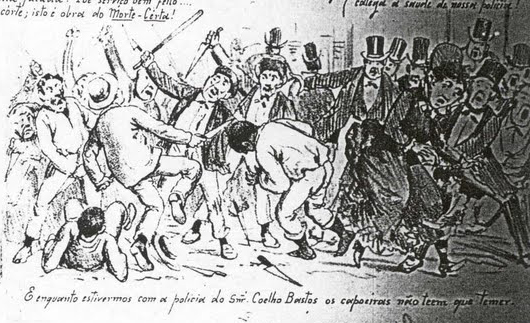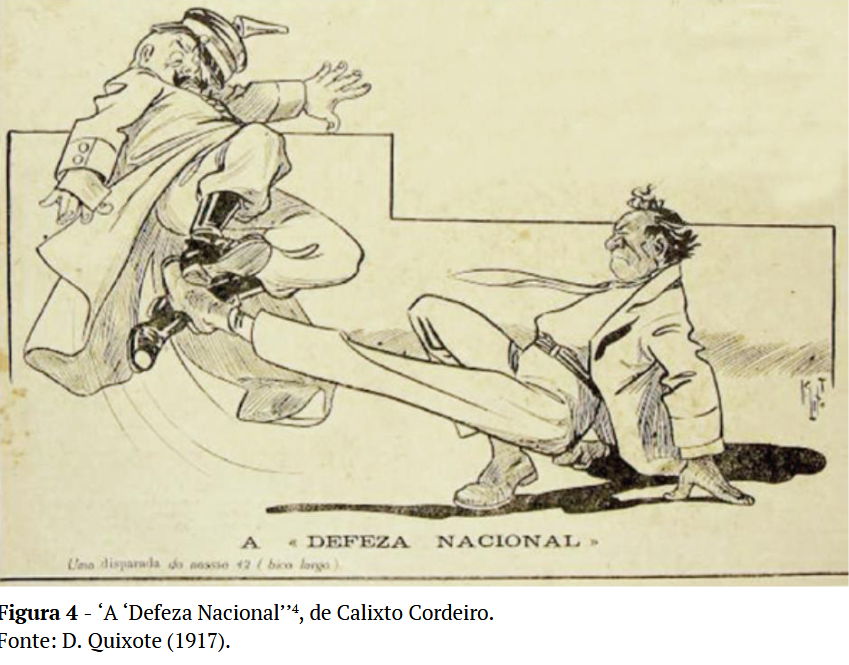
I recently wrote that no mass battles = no Carioca; there would be no Capoeira Carioca without gangs/mass battles of 19th century Rio.
Why is it so?
First, tactically and technically, Carioca was created in and for mass battles.
Before Carioca, capoeiragem had ginga - and it still has ginga, in Bahia. Ginga (the original one) is enough for one-on-one fighting or playing.
But once capoeiras of Rio started getting into mass battles (around 1850), ginga became too static for this environment; and naturally evolved into Peneiraçao, that allowed fighters to control the battlefield, move around, avoid getting swarmed, zoning multiple opponents(video). Peneiraçao is what you get if you try to ginga in a mass battle.
Peneiraçao is the secret weapon of Capoeira Carioca that allowed it to fight against multiple opponents.
But even tactically, having to fight more opponents at once influences the techniques you use.
In most martial arts, you are content to defeat one opponent. You defeat him - and go home.
But in mass battles, you want to defeat as many opponents as possible.
This is not the same as fighting one opponent N times (like they do in the movies); it is fighting N opponents at once. It is different - you do not concentrate on one opponent and then on another; you focus on several opponents at once.
People today believe it is impossible. But it is, in fact, quite natural - if you go into a boxing ring frequently and fight another boxer, you will learn to fight one opponent in the ring.
If you fight in mass battles frequently, you either die - or you will learn to fight several opponents at once (if you have a good martial art). There is no magic behind it.
For example, you will learn to move around a lot; a lot more than when fighting one opponent.
You will learn not to throw combos - because while you throw your combo against one opponent, other opponents can grab you from behind.
You learn to throw your opponent to the ground as fast as you can - because opponent that is not standing cannot swarm you and you can deal with his friends.
You learn not to grapple - because, again, while grappling one opponent, the others can grab you from behind.
Not accidentaly, these are the fighting principles of Capoeira Carioca. This is the 'why' behind Peneiraçao, Rasteira, Cabeçada solta, Cocada etc.
Note that you will not learn these things in a boxing ring; because in a boxing ring, there is just one opponent; so you have no motivation to fight like described above.
Excursus:
I know modern/sport martial artists laugh at 'the deadly street', and explicitly or implicitly say that ring is where the fighting is at. But even they should be able to acknowledge that if they were against more opponents in the ring, they would fight differently.
And that is precisely the core of the matter - you learn fighting N opponents by fighting N opponents; not by fighting one opponent and repeating it N times.
And I am not saying I do it or that somebody else should do it; just that Carioca fighters did it; and that is what shaped Capoeira Carioca.
But of course, modern martial artists would probably answer that fighting N opponents is impossible - but that is perhaps only them applying the principle 'I cannot do it, therefore it is impossible'.
It is good that Carioca gansters did not have the internet - otherwise, they would never create Capoeira Carioca, as they would 'know' it is impossible.

"Fighting multiple opponents is impossible." Too bad they did not know in old Rio. Peneiraçao and Cabeçada solta are shown (=were used in that situation).
Second, the environment of 19th century Rio was conductive to development of Capoeira Carioca even in other ways. For example, I published a video of RubberLegs Low Carioca rasteira; and wrote it can kill the opponent (by breaking his neck).
Now, when you read it, how are you going to try it out? Of course, you could experiment with really thick crash matts or a deep pool; but that is difficult and inconvenient, to say the least.
But if you lived in Rio of 19th century, what would you do to try out RubberLegs Low rasteira? Well, I guess you would put your hat on your head and go for a walk.
If you went to the right part of the city, sooner or later you would encounter somebody who would want a piece of you; and then, just by defending yourself, you would test the RubberLegs rasteira; and see if it breaks his neck or not.
And then you would go home.
While it is true that even today, especially big cities have parts where you can get attacked easily, most of them probably are not lawless enough so you could kill somebody by breaking his neck and then go home, without any trouble with law.
There would, again, be inconveniences.
Care to try out RubberLegs rasteira?

Today, not even a UFC champion can try out a potentially lethal technique. But the gansters of old Rio could; therefore, they probably had greater experience with actually killing people with their fighting techniques than a contemporary UFC champion has.
I am not saying it was a great way to live or something; just that this was the environment Carioca was created in.
And that is talking about one opponent. What if you had a technique that affected more opponents at once? Again, being able to participate in mass brawls almost daily would allow you to test it easily. Otherwise, it would be extremely inconvenient.
So not only old Rio had the motivation to create a battlefield combat art; but it also provided the means to test and develop its (often lethal) techniques and tactics.
This is rare; most people today have neither.
(And I am not even talking about the fact they did not have guns, so there was no other recourse than barehanded fighting).
It was this environment that caused 'normal' capoeiragem to be transformed into what became Carioca.
Gang-plagued old Rio was an ideal laboratory for creation of Carioca - an amazing battlefield martial art.
These circumstances will probably never repeat themselves - we have guns and laws now. But we still have the old Carioca, as a fascinating relic of this age.
You do not fight in mass battles where deaths are commonplace (I guess); but you can study a martial art of people who did - Capoeiragem Carioca.
This is a thing few contemporary martial arts can boast. Usually, the bottom line is 'well, we fought in the ring a lot' - meaning, against one opponent. If they were used against multiple opponents, it is an exception, not a rule.
(And I am not saying there were no other battlefield combat systems than Carioca - there were such beasts (for example, in old kungfu); but they are as good as dead today.)
This is the reason why Carioca feels weird to most people.
"Why do they not stand in place and throw punches/kicks combos, like any sane person? And instead they dance around in Peneiraçao and use bandas?"
That is because most people are familiar with duelling systems, ie those that work in the ring(on the tatami) against one opponent; and this is precisely what Carioca was NOT.
Standing in place and throwing punches/kicks combos would make you a sitting duck in a mass battle. You had to use Peneiraçao and bandas!
Excursus:
Even the bandas - legs-only throws - make perfect sense, because if you have to grab/clinch the opponent to throw him, you waste time and can get clinched back.
Plus, if your hands are free, you can push opponent's knife arm(s) to his body (Abafamento); so he cannot cut you while you take him down.
Try a judo/wrestling throw against somebody who is holding a knife, and come back to me if you survive it.
--
This is also why any attempts to convert Carioca into a ring-fighting art are at best suboptimal(Burlamaqui) and at worst misguided(Sinhozinho).
To use Carioca in a ring, you have to throw out most of what is great about Carioca. What you get is just kickboxing with some weird techniques thrown in.
-
So to sum it up:
Capoeiragem Carioca was a combat system created in and for mass street battles. Without this environment, it does not make sense; and naturally degenerates.
Notes:
1. This sheds some light on other things: For example, why Bahian capoeira still has ginga to this day. That is easy - because there never were gangs and mass battles in Sao Salvador; so there was no motivation for Bahian capoeira to change into a battlefield art (and thus lose ginga). Bahian capoeira was one-on-one game; and even Mestre Bimba kept it that way (see the way he preserved and created Baloes - Baloes are not fighting techniques, but game challenges).
If it was not for the gangs/mass battles, Carioca would have ginga too.
2. Sometimes, you can solve multiple opponents situation by using malandragem(situation production) to spread them out and fight one opponent by one. (see Mestre Bola Sete's book for example). But in a street mass battle, this is impossible - you either fight them all or run away.
3. It also hints at the probable cause of degeneration of Capoeira Carioca: As the gangs and mass battles started to dissapear in the first half of 20th century, there was no more motivation to keep the art functional at its highest level.
Instead, capoeiras fought in one-on-one street fights; gradually losing the high-level knowledge of the art (which was not needed anymore). In one-on-one, almost anything works.
(For example, note that Moraes Filho (1893) mentions Peneiraçao("Passo-a-dois"); Calixto(1907) shows Peneiraçao; and Cyriaco article (1906) says that Peneiraçao is the most basic technique of the art; while in 'Nosso jogo/Silhuetas' (1926), Peneiraçao is not shown anymore; and Burlamaqui(1928) mentions it only briefly in his book as "Pentear ou Peneirar".)
Then, people started to try and adopt Carioca capoeiragem for other things - sport-fighting (Burlamaqui), vale-tudo (Sinhozinho) or even some urban self-defence(name escapes me).
But this only further removed Carioca from its source - mass battles - and thus made it worse and worse as a fighting art.
It was the removal of capoeiragem Carioca from mass-battles which created it that caused its ultimate degeneration.
It is, again, extremely natural once you think about it - when there are mass battles all over the city, everybody wants to learn a battlefield martial art. But if there are no mass battles - how many people would like to learn a battlefield martial art? What for?
4. To complete the picture, read this:
"Perito na rasteira , o capoeira pode atirar ao chao em pouco tempo cinco ou seis pessoas." (Raul Pederneiras, 1921)
"With an expert rasteira [Carioca Low rasteira], capoeira can throw to the ground five or six people in a short time."
Five or six people! I guess Pederneiras probably did not mean they waited in a queue for the rasteira, eh? They probably attacked all at once.
Also this:
"Este golpe [Corta capim] quasi sempre e dado n'uma luta desequal, isto e, de um homem contra diversos." (Anibal Burlamaqui, 1928)
"This blow [Corta capim] is almost always used in an unequal fight, that is, one man against many."
Again, if you want to use Corta capim against many people, they probably have to attack all at once.
So you see that in 1920's, they still knew Carioca techniques were used against multiple opponents.
This Web Page was Built with PageBreeze Free HTML Editor